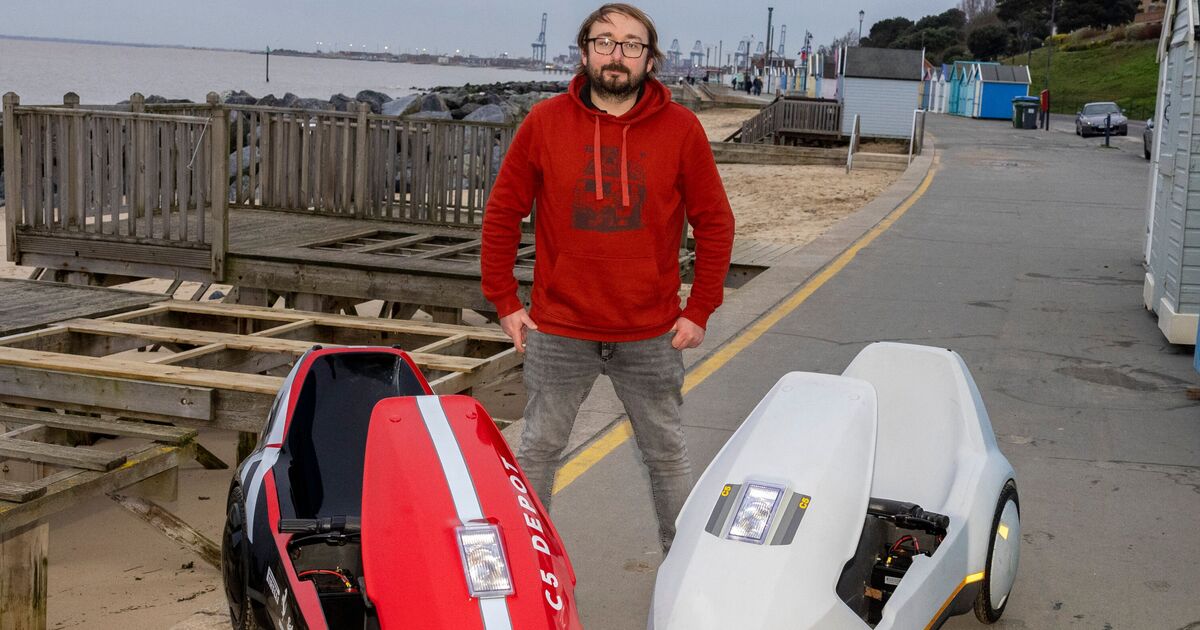
Sam Rowell and his collection of Sinclair C5s (Image: Phil Harris)
Airships, jetpacks, hoverboards, Segways…history has witnessed some very eccentric, and occasionally doomed, modes of transport. But one mode that stands out as the most eccentric of all is the Sinclair C5, the tiny electric car that first launched 40 years ago today.
The brainchild of British scientist Sir Clive Sinclair, this battery and pedal-powered personal vehicle was supposed to revolutionise our daily commuting – in the same way that electric cars, such as Elon Musk’s Tesla, are now transforming modern-day road travel.
Only, it turns out that Sinclair, who had made his fortune in home computers with the ZX Spectrum, was no Musk, and his C5 proved to be a total flop, right from the very start. Nonetheless, in the intervening four decades, this once-ridiculed vehicle has gained something of a cult following among growing numbers of fans for its quirky design and easy operation.
Across the UK, there are now C5 owners’ clubs for keen collectors and regular rallies, often featuring souped-up versions of the original. And this weekend, in celebration of the 40th anniversary of its launch, dozens of enthusiasts are bringing their C5s together for a special celebration in the exact same spot that the original launch took place – at Alexandra Palace, north London.
Sadly, Sinclair died in 2021 aged 81, but if he were still alive, he would feel some sort of vindication, knowing that his invention is finally getting the recognition he always felt it deserved.
Constructed mainly of polypropylene, the original C5 weighed just 30kg and measured less than 70 inches long.

Sinclair C5 aficionados gather with their quirky electric vehicles at a meet in Brighton (Image: Supplied)
It initially sold at £399, although it was so unpopular that many were quickly discounted. Drivers sat in a cockpit, steering somewhat clumsily with a handlebar beneath their knees. Rather like modern-day electric bicycles, they could give the battery-powered three-wheeler an extra boost by pedalling, although the top speed was limited to a sluggish 15mph and the range well under the advertised 20 miles – all of which added to the vehicle’s goofy image.
Back in January 1985, Sinclair launched his invention to great fanfare, boosted by a £3million, three-month-long print and television advertising campaign.
In an accompanying press release, he insisted: “It should appeal equally to short journey commuters; the housewife for local shopping; and the younger generation as a safer alternative than conventional motorised two-wheelers.” Sinclair was confident his C5 would “radically reshape and expand the market for practical, personal transport”.
He added: “The vast majority of our test-drivers have found C5 an exhilarating experience to drive.”
The problem was, his invention wasn’t exhilarating in the slightest.
Engineers were sniffy about its low speed and basic design, while motoring organisations worried it was unsafe.
The manufacturers claimed they sold 5,000 vehicles, although sceptics suspected it was far less. Certain celebrities couldn’t resist it, though.
Princes William and Harry had one each to drive around Kensington Palace before they were old enough to get behind the wheel of a car. Pop star Elton John, magician Paul Daniels and sci-fi writer Sir Arthur C Clarke were also owners.
Forty years on, one person who knows the C5 better than anyone else is Sam Rowell, a collector and restoration expert who lives in the Suffolk port town of Felixstowe, where he keeps 57 original models worth an estimated £30,000, many of which he has renovated and modified.
Today, along with other aficionados at Alexandra Palace, he will be proudly driving the highest-performance C5 in his collection, a shiny red and black original model which he has converted to reach speeds of up to 36mph – considerably faster than anything Sinclair created.
Also attending the anniversary celebration will be the managing director and the vehicle designer of the original C5.
At 32 years old, Rowell is too young to have witnessed the C5 at its birth in the mid-1980s, but when he’s not at his day job as an IT developer, he admits to being more than a little obsessed with these charming vehicles.
In his garage, and in various storage facilities dotted across the surrounding area, are the C5s that comprise his collection – some fully functional, others only half-restored.

Sir Clive Sinclair launches the Sinclair C5 in January 1985 (Image: Getty Images)
A passionate mechanic, Rowell first embarked on his C5 journey eight years ago, after test-driving Sinclair’s invention at a car rally. Since then he has sourced original models online – many in serious need of attention – or found them dumped at recycling centres, or in people’s back gardens.
He now runs a C5 restoration business called C5 Depot.
“As soon as you sit in one, it starts to make sense,” he says, explaining hislove for the eccentric vehicle. “They’re great fun to ride and they’re easy to work on.”
Out on the streets of Felixstowe, people often ask him if he’s driving a replica. “I tell them I may be mad enough to restore them, but I’m not mad enough to make new ones. Many people don’t actually realise they can be fixed up.”
Back in his cluttered garage, Rowell explains the repairs and conversions he carries out. As well as replacing the old plastic gear boxes – which melted – with metal ones, he also adds improved bearings and modern LED lights. Using a 3D printer, he is also able to replace any battered polypropylene bodywork.
He typically sells his fully restored C5s for around £2,000.
By switching out the old 12-volt lead-acid batteries for new 24-volt lithium ones, he can boost the C5’s top speed, too. After a bit of rewiring and tinkering with the speed controller, he can more than double the original top speed, although he stresses that electric bicycles – for that’s what the C5 is classed as – that exceed 15mph can legally only be used on private land.

Elon Musk speaks launches the Tesla Mode X Crossover SUV in 2015 (Image: Getty Images)
What about racing Sinclair C5s? At the mention of this crazy idea, Rowell’s eyes light up. “Imagine a C5 drag race,” he says. “That would be fun.”
Remarkably, the speed record for a C5 stands at 150mph – set in 2004 by British stunt driver Alan Harper. Rowell has a theory about why the dodgem-style rides have such cult status now.
C5s are classic cars, yet you can pick up an old one for under £1,000, he explains. This then introduces you to the world of classic and retro car clubs and rallies.
“If you turn up to a classic car show in your C5 and park it next to a Ferrari, your C5 will get more attention than the Ferrari,” he insists. “People say ‘Wow! A Sinclair C5!’”
Rowell also loves the reactions he gets from the public when he’s out driving.
“People either remember them from the 1980s or they tell me they’ve never seen one before and that it looks really cool. Yes, of course it’s an Eighties vehicle, but it still looks modern and space-age, even today, because it’s so unique.”
So why was the original launch such an unmitigated failure?
After all, Sir Clive Sinclair was a successful scientist, and the brains behind the world’s first slimline calculator and the ground-breaking ZX Spectrum computer, among other great inventions. In 1983, two years before the C5 debacle, he had been knighted for his services to industry.
Rowell believes Sinclair had a great idea, just at the wrong time in history. He made the mistake of creating enormous hype and then launching the C5 as a serious electric car, when in fact it was a three-wheeler with pedals and the driver’s body was exposed to the elements. Nor did the decision to unveil it in the depths of winter help. No wonder it was a damp squib.
Rowell believes Sinclair would have been far more successful if he’d marketed the C5 simply as a bit of fun. “If the motor had had a little more power and if they had had the battery technology we have today, then it would have been great.”
The original 1985 press release revealed Sinclair’s enormous ambition for his new invention.
It stated boldly: “By the early 1990s, Sir Clive foresees a complete range of traffic-compatible, quiet and economical family vehicles.”
But was the C5 really a prototype for today’s electric motor cars? Was Sinclair some sort of 1980s version of Elon Musk?
Rowell doesn’t think that comparison is too wild. “If the C5 had been successful, Sinclair would have made the C10 and then the C15. His dream was always tomake a proper electric car, but the funding wasn’t there.”
He’s not aware that Sinclair and Musk ever met. But, intriguingly, when Sinclair died in 2021, it was Musk who led the tributes.
“RIP, Sir Sinclair,” he wrote on Twitter. “I loved that computer.”
No mention of the C5.












